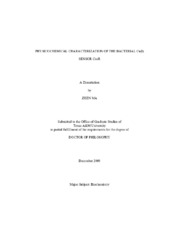| dc.description.abstract | M. tuberculosis copper-sensitive operon repressor (Mtb CsoR) is the founding
member of a new metalloregulatory protein family in prokaryotes that regulates the
transcription of the cso operon in response to copper toxicity. Mtb CsoR tetramer binds 1
monomer mol equiv of Cu(I) with very high affinity (log KCu=18.0) via three conserved
residues, Cys36, His61' and Cys65'. Binding of Cu(I) allosterically inhibits the CsoR
binding to the DNA operator (CsoO) overlapping the cso promoter (DeltaGc=+3.6 kcal/mol,
pH 7.0, 25 oC). These findings are consistent with a role of CsoR as a transcriptional
repressor with Cu(I) binding inducing transcriptional derepression. To explore the
mechanism of this regulation, His61 was substituted with 1-methylhistidine (MeH) or Beta-
(2-thiazolyl)-alanine (Thz) using a native chemical ligation strategy. The CsoO binding
affinities of the resultant H61MeH and H61Thz CsoRs are both refractory to inhibition
by Cu(I) binding despite the fact that each forms a high affinity 3-coordinate complex
with Cu(I). This suggests that while Cu(I) is coordinated by the N?11 atom of His61, the
N?22 atom plays an critical role in driving this allosteric switch. Evidence in support of a
formation of a hydrogen bonding network involving the N?1 face of His61 and two
conserved "second coordination shell" residues, Glu81' and Tyr35, is presented. Remarkably, this mechanism is analogous to that proposed for the Zn(II) sensor CzrA
from S. aureus. To test this, we employed the same native chemical ligation approach to
substitute the key Zn(II) ligand His97 with 1-methylhistidine; with the preliminary
findings fully consistent with an intersubunit allosteric switch involving the N?2 face of
this key His97 residue in CzrA.
Two predicted homologs of Mtb CsoR were also biochemically characterized to
obtain additional support for the hypothesis that CsoR is a key Cu(I) regulatory protein
in many bacterial species. B. subtilis CsoR, known to regulate the transcription of the
copZA operon, was found to have biochemical properties similar to those of Mtb CsoR
as to Cu(I) binding, DNA binding and Cu(I)-dependent allosteric regulation.
Interestingly, Bsu CsoR also binds other divalent metal ions (Zn, Ni) with high affinity
but with metal coordination geometries distinct from that of Cu(I). Binding of these
divalent metal ions only weakly regulates copZA operator binding in vitro, suggesting
that coordination number and geometry are most closely related to the allosteric
regulation. Finally, a putative CsoR from the pathogenic S. aureus Newman strain was
identified and characterized, and was found to exhibit biochemical properties similar to
those of Mtb and Bsu CsoRs. Parallels between Cu(I)-sensing CsoRs and functional
orthologs in the CsoR/RcnR family are further discussed in the context of the
mechanism and evolutionary divergence of this new family of regulatory proteins. | en |


